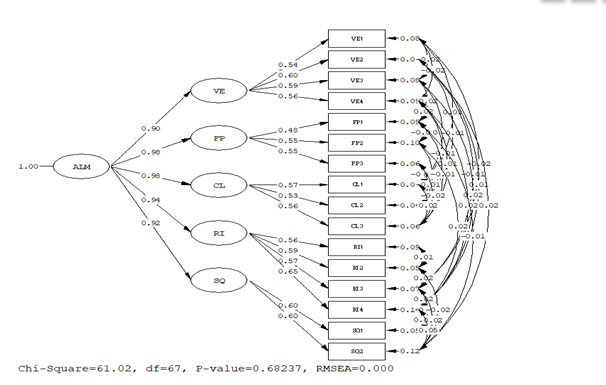รูปแบบภาวะผู้นำทางวิชาการของผู้บริหาร คณะพยาบาลศาสตร์ สถาบันพระบรมราชชนก: องค์ประกอบและตัวบ่งชี้
คำสำคัญ:
ภาวะผู้นำทางวิชาการ, ผู้บริหาร, องค์ประกอบ, ตัวบ่งชี้บทคัดย่อ
การวิจัยแบบขั้นตอนเชิงอธิบายนี้มีวัตถุประสงค์เพื่อพัฒนารูปแบบความเป็นผู้นำทางวิชาการของผู้บริหารวิชาการพยาบาล คณะพยาบาลศาสตร์ สถาบันพระบรมราชชนก (สบช.) ประกอบด้วย 2 ขั้นตอน คือ ขั้นตอนที่ 1 เป็นการวิจัยเชิงคุณภาพ โดยการวิเคราะห์เอกสาร และการสัมภาษณ์ออนไลน์เพื่อระบุปัจจัยและตัวชี้วัดของร่างแบบจำลอง AL ผู้ให้ข้อมูลสำคัญในการสัมภาษณ์ คือ ผู้บริหารวิชาการพยาบาล 13 คน นักศึกษาพยาบาล และผู้ปกครอง อย่างละ 11 คน และการอภิปรายกลุ่มเพื่อรวบรวมความคิดเห็นของผู้เชี่ยวชาญ 9 คน ในการพัฒนาแบบจำลอง AL โดยแบบจำลองโมเดลประกอบด้วย องค์ประกอบหลัก 5 ด้าน องค์ประกอบย่อย 16 ด้าน และ 97 ตัวบ่งชี้ แบบจำลองได้ถูกทดสอบความตรงด้านเนื้อหา ซึ่งได้ค่า IOC อยู่ในช่วง 0.6-1.0 และขั้นตอนที่ 2 เป็นการวิจัยเชิงปริมาณเพื่อทดสอบแบบจำลอง AL โดยใช้การวิเคราะห์ปัจจัยยืนยัน (CFA) กับกลุ่มตัวอย่าง 271 คน ผลการวิจัย พบว่า
การวัดลำดับที่สองของแบบจำลอง AL มีดัชนีความสอดคล้องกลมกลืน (χ2/df) เท่ากับ 0.68237, GFI = 0.97, AGFI = 0.94, SRMR = 0.0063, RMSEA = 0.000 โดยองค์ประกอบย่อยที่สำคัญของแบบจำลอง คือ VE2 (L = 0.60) FP2 (L = 0.55) FP3 (L = 0.55) CL1 (L = 0.57) RI4 (L = 0.65) SQ1 (L = 0.60) และ SQ2 (L = 0.60)
จากผลการวิจัยครั้งนี้ แบบจำลองควรนำไปใช้ในการเตรียมและพัฒนาผู้บริหารมือใหม่และผู้บริหารที่กำลังดำรงตำแหน่งในคณะพยาบาลศาสตร์ สบช.
เอกสารอ้างอิง
Alomari, A., Hunt, L., Lord, H., Halcomb, E., Fernandez, R., Middleton, R., et al. (2021). Understanding the support needs of Australian nursing students during COVID-19: A cross-sectional study. Contemporary Nurse, 57(3-4), 258-268.
Anthony, S. G., & Antony, J. (2017). Academic leadership – special or simple. International Journal of Productivity and Performance Management, 66(5), 630-637.
Bellibas, M. S., Ozaslan, G., Gumus, E., & Gumus, S. (2016). Examining department chairs, needs in performing academic leadership in Turkish universities. Egitim Ve Bilim, 41(184), 91-103.
Bouws, M., Madeira, A., & Streberger, A. (2020). Fulfillment in the role of academic nurse leader: A grounded theory study. Journal of Professional Nursing, 36, 469-476.
Charoenchai, W., Kunacheva, N., Niyomves, B., & Kenaphoom, S. (2022). The composition synthesis of high-performance organization. Journal of Modern Learning Development, 7(2), 438-54 (in Thai).
Eyal, E. & Nitza, D. (2020). Academic rank and position effect on academic research output-A case study of Ariel University. International Journal of Higher Education, 10(1), 295-307.
Farahani, M. A., Ghaffari, F., Oskouie, F., & Tafreshi, M. Z. (2017). Attrition among Iranian nursing students: A qualitative study. Nurse Education in Practice, 22, 98–104.
Fernandez, J., Ardzejewska, K., & Haddad, A. (2019). Higher education private provider quality network (HEPP-QN). Proceeding of Higher Education Private Provider-Quality Network (HEPP-QN) Forum, Cooranbong, Australia. 1-20.
Giddens, J., & Morton, P. (2018). Pearls of wisdom for chief academic nursing leaders. Journal of Professional Nursing, 34(2), 75-81.
Guthrie, K. M. (2019). Challenges to higher education’s most essential purposes. Retrieved from https://sr.ithaka.org/wp-content/uploads/2019/04/SR-issue-brief-challenges-higher-education-essential-problems-20190409.pdf.
Hair, J. F., Black, W. C., Babin, B. J., & Anderson, R. E. (2018). Multivariate Data Analysis (8th ed.). United Kingdom: Cengage Learning.
Inwang, C., Peechapol, C., Jindamanee, T., & Somboonpol, U. (2017). An academic leadership developmental model by knowledge management of executives from private universities. Journal of Business Administration, The Association of Private Higher Education Institutions of Thailand, 6(1), 114–129.
Justice, G. (2019). How to be a dean. Johns Hopkins University Press. Keating, S. B., & DeBoor, S. S. (2017). Curriculum development and evaluation in nursing (4th ed.). Springer Publishing Company.
Kiral, E., & Basaran, R. (2019). Academic leadership. In T. Fidan. Vocational identity and career construction in education (238-257). Turkey: IGI Global.
Krejcie, R. V. & Morgan, D. W. (1970). Determining sample size for research activities. Educational and Psychological Measurement, 30(3), 607-610.
McClelland, D. C. (1973). Testing for competence rather than for intelligence. American Psychologist. 28(1), 1-14
Memon, M. A., Ting, H., Cheah, J. H., Thurasamy, R., Chuah, F., & Cham, T. H. (2020). Sample size for survey research: Review and recommendations. Journal of Applied Structural Equation Modeling, 4(2), 1-20.
Mitsilapin, S., Anannawee, P., & Pruetikul, S. (2018). Instructional leadership of administrators and organization culture of schools affecting teacher’s job motivation in secondary schools, Chachoengsao province under the secondary educational service area office 6. Journal of Educational, Thaksin University, 18(1), 191–201.
Montgomery, B. (2020). Academic leadership: Gatekeeping or groundskeeping? The Journal of Values Based Leadership, 13(2), Article 16.
Mundt, M. H. (2018). Reflections on a dean's career: Lessons learned. Journal of Professional Nursing. 34(2), 142-146.
Neal-Boylan, L., Guillett, S. E., & Sharon, C. (2018). Academic leadership in nursing: Effective strategies for aspiring faculty and leaders. New York: Springer.
Oermann, M. H., De Gagne, J. C., & Phillips, B. C. (2017). Teaching in nursing and role of the educator: The complete guide to best practice in teaching, evaluation, and curriculum development (3rd ed.). NY: Springer Publishing Company.
Parker, S. & Ahire, V. S. (2019). Role of academic leadership in bringing about a transformational change in the organizational behavior of Hei’s in India. International Journal of Trend in Scientific Research and Development, 3(5), 2300-2305.
Peterson, J. F. (2015). Creative leadership for interdisciplinary education. The International Journal of Educational Organization and Leadership, 22(4), 71-89.
Piyasiripan, N., Phuangsomjit, C., Sirisanglert, K., & Hingkanont, P. (2018). Scenario of competencies of nursing education institute administrator during the next decade. Veridian E-Journal, Silpakorn University, 11(1), 3611-3633.
Pudpong, N. (2016). Public and private nursing schools in Thailand: How does type of training institution affect nurses' attitudes and job choices? Retrieved from https://resyst. lshtm.ac.uk/resources/public-and-private-nursing-schools-in-thailand-how-does-type-of-training-institution.
Putpa, C. (2022). Academic Leadership of School Administrators Affecting High Performance Organizations of secondary schools in Yasothon Province. Journal of Social Science for Local Rajabhat Mahasarakham University, 6(1), 98-106.
Ratchapakdee, P., Sehakom, V., Wonganusit, V., & Chamnankit, P. (2021). Education for sustainable development among nursing students. Udonthani Hospital Medical Journal, 29(3), 484-500 (in Thai).
Smith, S., Hallowell, S. C., & Lloyd-Fitzgerald, J. (2018). AACN's DNP essential II prepares clinicians for academic leadership: Three DNP graduates share their leadership journey. Journal of Professional Nursing, 34(1), 16-19.
Udin, U., Handayani, S., Yuniawan, A., & Rahardja, E. (2019). Leadership styles and communication skills at Indonesian higher education: patterns, influences, and applications for organization. Organizations and markets in emerging economies, 10(1), 111-131.
Youngquist, J., Line, D., & Pyle, S. (2019). Academic leadership and creativity. The Department Chair, 29(4), 20-22. 78–93. (in Thai)
Yoelao, D. (2014). The study of PBL-based learning management from the knowledge building project to enhance the skills of the 21st century of children and youth: based on the success experiences of Thai schools. Bangkok: Limited Partnership Thippawisut. (in Thai)

ดาวน์โหลด
เผยแพร่แล้ว
ฉบับ
ประเภทบทความ
สัญญาอนุญาต
ลิขสิทธิ์ (c) 2023 วารสารเครือข่ายวิทยาลัยพยาบาลและการสาธารณสุขภาคใต้

อนุญาตภายใต้เงื่อนไข Creative Commons Attribution-NonCommercial-NoDerivatives 4.0 International License.
1. บทความหรือข้อคิดเห็นใด ๆ ที่ปรากฏในวารสารเครือข่าย วิทยาลัยพยาบาลและการสาธารณสุขภาคใต้ ที่เป็นวรรณกรรมของผู้เขียน บรรณาธิการหรือเครือข่ายวิทยาลัยพยาบาลและวิทยาลัยการสาธารณสุขภาคใต้ ไม่จำเป็นต้องเห็นด้วย
2. บทความที่ได้รับการตีพิมพ์ถือเป็นลิขสิทธิ์ของ วารสารเครือข่ายวิทยาลัยพยาบาลและการสาธารณสุขภาคใต้







